Will It Lens? Part 2
In case you missed it, here's part 1 of our adventures with the 3'x4' fresnel lens. Oh, man. I have lots more pictures. The same SAFETY NOTE as last time applies again, but with a few more additions. You should probably wash your hands after you're done handling stuff in the lens. In particular, when you heat copper up until it turns black, you've probably made copper (II) oxide, which is a somewhat nasty irritant. I also make no guarantees about how many carcinogens we've made/touched/breathed, although so far I still feel healthy (no cancer in the past week!). Speaking of health hazards, if you use a frying pan to hold stuff, make sure it doesn't have a Teflon non-stick coating! That coating will burn away and become a huge safety hazard (it's mainly fluorine, and most fluorine compounds are toxic, volatile, and several other kinds of nasty; quite a few fluorine compounds were used as chemical weapons and precursors to sarin nerve gas, so avoid it at all costs). We got a cast-iron skillet, which is reasonably safe and inert, and it doesn't melt until we break 1800K, which is very unlikely with our current setup.
Anyway, on to the results.
For better or worse, we tried CDs. To be thorough, we looked at both a professionally made, non-writable CD (which uses actual dimples in actual metal to encode its data) and a CD-R (which uses some sort of photosensitive material that changes from reflective to nonreflective when you shine certain frequencies of light on it, and is therefore not made out of metal). Both of them made terrible-smelling smoke.

The CD-R cracked a bit around the edges and had a large hole burned clear through the whole thing:
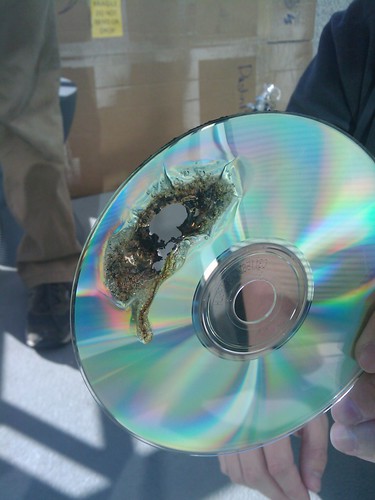
The CD, however, was made of sturdier stuff, in that we melted it but didn't burn all the way through as easily.

The metal within it cracked into lots of small pieces in this beautiful, artsy sort of pattern. The black stuff is just smoke that didn't drift away; you can see where I wiped some off with my finger at the top.
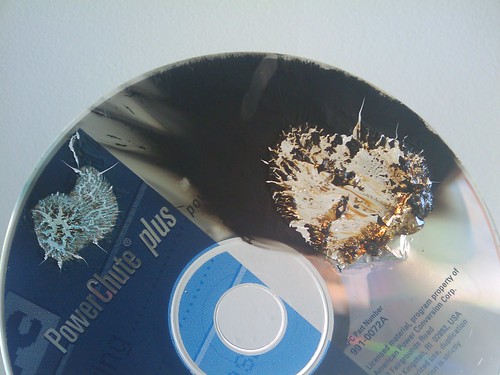
More interestingly, however, was what the label on the front did. I'm not sure what happened, but it was something different than the unlabeled part.
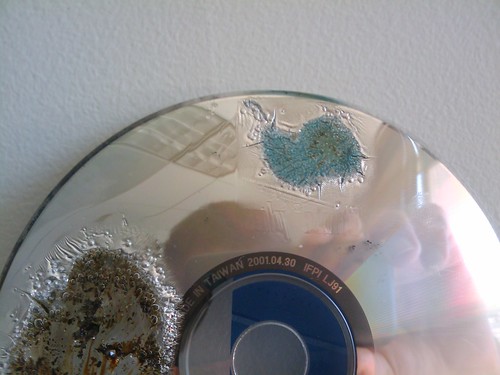
You can see the diagonal line heading up and left, and under it are the backwards words "Chute® plus" which was what was written on the front at that part, right next to a vertical line separating the part with a label on it from the part without one. It doesn't show up well in the picture, but there's this great pattern of dots of exactly where the ink is on the front (the way newspapers do color by lots of little dots; it's that same pattern). We're not sure what caused that. It might be the ink melted and somehow reacted (or heated/deformed?) the metal underneath it. It might be that the printing process slightly weakened the substrate onto which it was printed, so that part had structural failures earlier than the nearby areas. I dunno, but I thought it was darn interesting. Also interesting is that heating and cooling the CD apparently introduced some new stress into it; it developed large cracks several hours later (not immediately!).
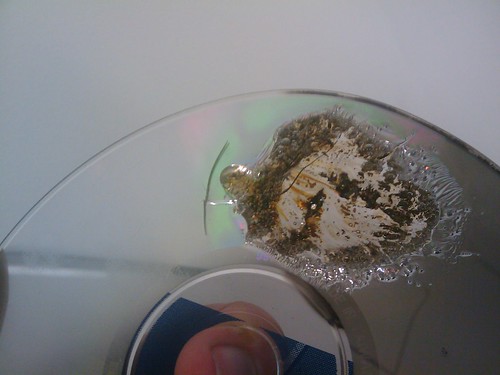
We've been refining our setup. We now have a frame to keep the lens flat and focused, and a stand so that we don't have to hold it (and so that the focal point doesn't wobble around every time someone moves).
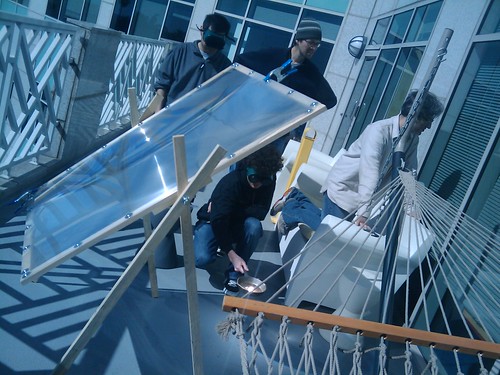
We've also got more people watching the reflection in the window, which is much easier on the eyes. I've been viewing nearly everything through the display on my camera, which seems like another good way to go (assuming I don't burn out the CCD in the camera, which hasn't happened yet, knock on wood!). The people who need to watch the events directly still prefer to use the goggles, since it's much easier to position the frying pan when you're looking at it, rather than its reflection. However, the goggles aren't quite good enough, and the light is still blinding, as shown in this picture:
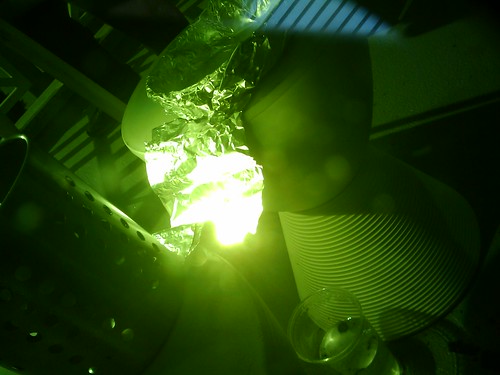
At this point we were using an aluminum foil bridge strung between two end tables; it wasn't the best idea we've had, since it was really hard to position the focal point correctly. Anyway, I forget what the goggles are rated for, but they're not good enough for looking at the sun. However, they're still the preferred method if you need to hold the frying pan, since they're way better than nothing.
Speaking of the frying pan, it's pretty much supplanted all other forms of holding items in the focal point. Here's some tableware from the cafeteria.
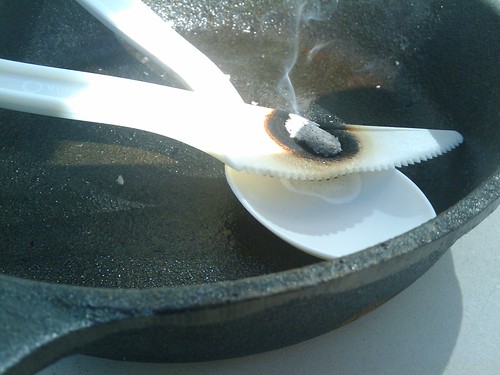
This knife and spoon are made out of potato, in some bizarre attempt to be environmentally friendly (which I don't fully understand because they're not recyclable). Nothing too exciting, but it's neat to see it puff up (perhaps something inside was boiling?). I also wish I knew what changes between the charred black parts and the white ashes. ...what is ash, anyway? I assume there's still carbon in there because I can't imagine it all went away as smoke and/or carbon dioxide, but I don't know how to account for the dramatic color change between the two. So, if you have hypotheses, I'd like to hear them!
We revisited coins, hoping we could get a pre-1982 (95% copper) penny to melt. Alas, it only turned black. The black stuff was just on the surface of the penny, however, and flaked off.
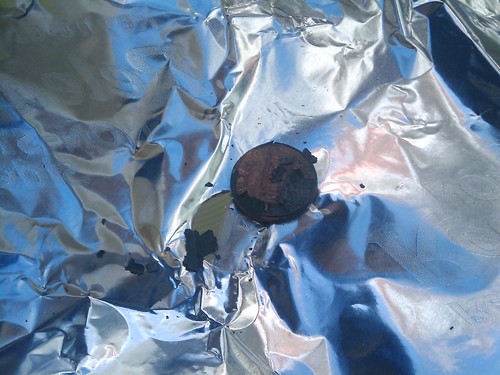
We're pretty sure that's copper (II) oxide, or CuO. Remember that it will irritate your skin, so wash your hands when you're done with this stuff. Also, you can see a circular hole in the aluminum foil. That was where the penny had been, and it melted the aluminum where the two were in contact! The heat then dissipated through the rest of the aluminum and radiated away, so the rest of it stayed solid. Neat!
Incidentally, it turns out that we have non-stick aluminum foil, which means that one side has a special non-stick coating. We're not really sure what it is, but it kinda looks like wax when it melts (see the very bottom part of the photo).
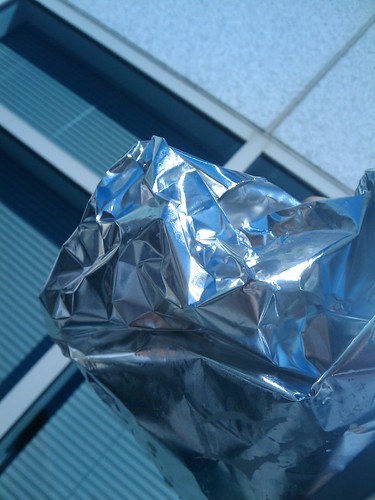
We doubt it's fluorine based, since we're pretty sure that would be really expensive to make. and so far none of us have lost our lungs, so it can't be all that bad (we hope!).
We tried some more post-1982 (copper-plated zinc) pennies, but since we weren't holding them with the pliers, we could lens them long after the zinc melted.

Watching through the welding goggles was amazing, as you could actually watch the zinc melt. The copper would crinkle up at the focal point and then the crinkly part would gradually radiate outward from there until the whole penny was like this. I think it would be neat to try to get a penny halfway through this process, so part was crinkly and part wasn't, but that might be too hard. and speaking of hard to do, for over a week I've been trying to make a brass penny with this thing. Brass is an alloy of copper and zinc, and I've done it before with a bunsen burner, but it's hard to do with the lens because you need the penny hot enough to melt the zinc yet cool enough to not oxidize the copper too much. We finally managed to do it using a stack of pennies (which promptly fell over, since it was in the frying pan).
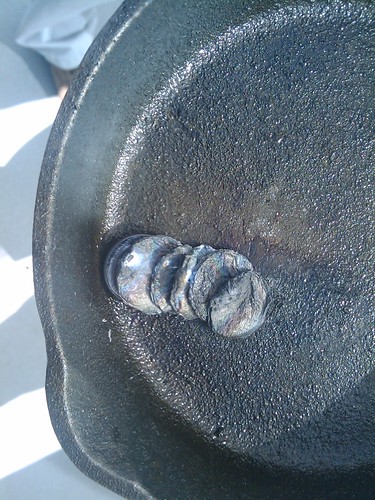
Most of the pennies oxidized and fused together (not sure if that was mushy copper that fused, or if the zinc just melted and flowed between them). Oddly enough, there was some white stuff formed in these things, and it was soft enough that you could deform it with your fingernail.
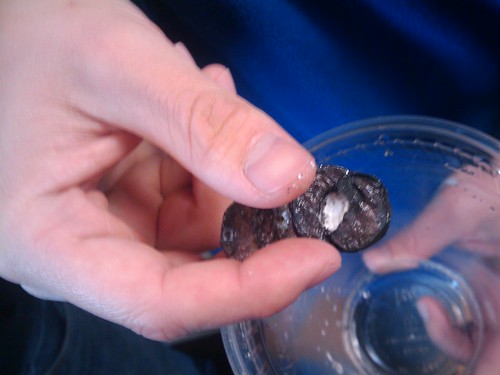
We're honestly not sure what that is; we'll have to do more experimentation. Edit: it's probably zinc oxide. Anyways, most of the pennies fused together, but the one on the very bottom was at the right temperature, and turned to brass!
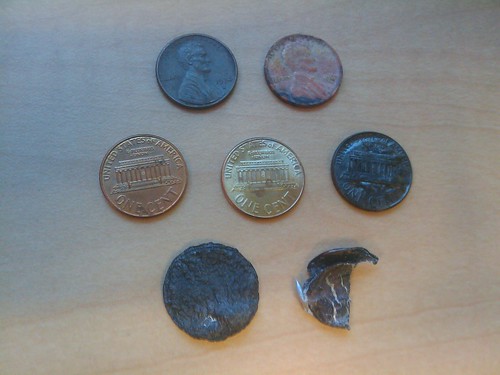
So here's all our pennies. The top row are the old, solid copper ones: the left is normal, and the right is lensed with the CuO scraped off. We're not sure what the remaining color change is all about; it might be some other kind of alloy, but we honestly have no idea. The middle and bottom rows are all new, copper-plated zinc pennies. The middle row is an unmodified coin, our brass penny, and one that got burned. The bottom row is one that got heated so much that the zinc in the bottom right area began to boil (yes, this is plausible because zinc boils at a cool 1180K, which is colder than the melting point of copper. Assuming we boiled it, we've narrowed our maximum temperature to somewhere in the 1180-1356K range), and the first penny we ever lensed (where we held it with pliers, so the zinc slag dripped out and the copper shell collapsed in on itself).
It's late, and I should go to bed, but I've got more updates in the lensing area coming soon. To whet your appetite for the next installment, here's a sneak preview:
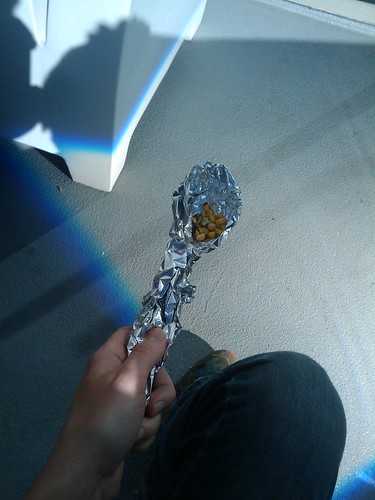

Until next time, make sure to have safety, fun and learning (in that order), and always remember that science is awesome!
Edit: To find out what happens to the popcorn, check out part 3!
Anyway, on to the results.
For better or worse, we tried CDs. To be thorough, we looked at both a professionally made, non-writable CD (which uses actual dimples in actual metal to encode its data) and a CD-R (which uses some sort of photosensitive material that changes from reflective to nonreflective when you shine certain frequencies of light on it, and is therefore not made out of metal). Both of them made terrible-smelling smoke.

The CD-R cracked a bit around the edges and had a large hole burned clear through the whole thing:

The CD, however, was made of sturdier stuff, in that we melted it but didn't burn all the way through as easily.

The metal within it cracked into lots of small pieces in this beautiful, artsy sort of pattern. The black stuff is just smoke that didn't drift away; you can see where I wiped some off with my finger at the top.

More interestingly, however, was what the label on the front did. I'm not sure what happened, but it was something different than the unlabeled part.

You can see the diagonal line heading up and left, and under it are the backwards words "Chute® plus" which was what was written on the front at that part, right next to a vertical line separating the part with a label on it from the part without one. It doesn't show up well in the picture, but there's this great pattern of dots of exactly where the ink is on the front (the way newspapers do color by lots of little dots; it's that same pattern). We're not sure what caused that. It might be the ink melted and somehow reacted (or heated/deformed?) the metal underneath it. It might be that the printing process slightly weakened the substrate onto which it was printed, so that part had structural failures earlier than the nearby areas. I dunno, but I thought it was darn interesting. Also interesting is that heating and cooling the CD apparently introduced some new stress into it; it developed large cracks several hours later (not immediately!).

We've been refining our setup. We now have a frame to keep the lens flat and focused, and a stand so that we don't have to hold it (and so that the focal point doesn't wobble around every time someone moves).

We've also got more people watching the reflection in the window, which is much easier on the eyes. I've been viewing nearly everything through the display on my camera, which seems like another good way to go (assuming I don't burn out the CCD in the camera, which hasn't happened yet, knock on wood!). The people who need to watch the events directly still prefer to use the goggles, since it's much easier to position the frying pan when you're looking at it, rather than its reflection. However, the goggles aren't quite good enough, and the light is still blinding, as shown in this picture:

At this point we were using an aluminum foil bridge strung between two end tables; it wasn't the best idea we've had, since it was really hard to position the focal point correctly. Anyway, I forget what the goggles are rated for, but they're not good enough for looking at the sun. However, they're still the preferred method if you need to hold the frying pan, since they're way better than nothing.
Speaking of the frying pan, it's pretty much supplanted all other forms of holding items in the focal point. Here's some tableware from the cafeteria.

This knife and spoon are made out of potato, in some bizarre attempt to be environmentally friendly (which I don't fully understand because they're not recyclable). Nothing too exciting, but it's neat to see it puff up (perhaps something inside was boiling?). I also wish I knew what changes between the charred black parts and the white ashes. ...what is ash, anyway? I assume there's still carbon in there because I can't imagine it all went away as smoke and/or carbon dioxide, but I don't know how to account for the dramatic color change between the two. So, if you have hypotheses, I'd like to hear them!
We revisited coins, hoping we could get a pre-1982 (95% copper) penny to melt. Alas, it only turned black. The black stuff was just on the surface of the penny, however, and flaked off.

We're pretty sure that's copper (II) oxide, or CuO. Remember that it will irritate your skin, so wash your hands when you're done with this stuff. Also, you can see a circular hole in the aluminum foil. That was where the penny had been, and it melted the aluminum where the two were in contact! The heat then dissipated through the rest of the aluminum and radiated away, so the rest of it stayed solid. Neat!
Incidentally, it turns out that we have non-stick aluminum foil, which means that one side has a special non-stick coating. We're not really sure what it is, but it kinda looks like wax when it melts (see the very bottom part of the photo).

We doubt it's fluorine based, since we're pretty sure that would be really expensive to make. and so far none of us have lost our lungs, so it can't be all that bad (we hope!).
We tried some more post-1982 (copper-plated zinc) pennies, but since we weren't holding them with the pliers, we could lens them long after the zinc melted.

Watching through the welding goggles was amazing, as you could actually watch the zinc melt. The copper would crinkle up at the focal point and then the crinkly part would gradually radiate outward from there until the whole penny was like this. I think it would be neat to try to get a penny halfway through this process, so part was crinkly and part wasn't, but that might be too hard. and speaking of hard to do, for over a week I've been trying to make a brass penny with this thing. Brass is an alloy of copper and zinc, and I've done it before with a bunsen burner, but it's hard to do with the lens because you need the penny hot enough to melt the zinc yet cool enough to not oxidize the copper too much. We finally managed to do it using a stack of pennies (which promptly fell over, since it was in the frying pan).

Most of the pennies oxidized and fused together (not sure if that was mushy copper that fused, or if the zinc just melted and flowed between them). Oddly enough, there was some white stuff formed in these things, and it was soft enough that you could deform it with your fingernail.

We're honestly not sure what that is; we'll have to do more experimentation. Edit: it's probably zinc oxide. Anyways, most of the pennies fused together, but the one on the very bottom was at the right temperature, and turned to brass!

So here's all our pennies. The top row are the old, solid copper ones: the left is normal, and the right is lensed with the CuO scraped off. We're not sure what the remaining color change is all about; it might be some other kind of alloy, but we honestly have no idea. The middle and bottom rows are all new, copper-plated zinc pennies. The middle row is an unmodified coin, our brass penny, and one that got burned. The bottom row is one that got heated so much that the zinc in the bottom right area began to boil (yes, this is plausible because zinc boils at a cool 1180K, which is colder than the melting point of copper. Assuming we boiled it, we've narrowed our maximum temperature to somewhere in the 1180-1356K range), and the first penny we ever lensed (where we held it with pliers, so the zinc slag dripped out and the copper shell collapsed in on itself).
It's late, and I should go to bed, but I've got more updates in the lensing area coming soon. To whet your appetite for the next installment, here's a sneak preview:

Until next time, make sure to have safety, fun and learning (in that order), and always remember that science is awesome!
Edit: To find out what happens to the popcorn, check out part 3!